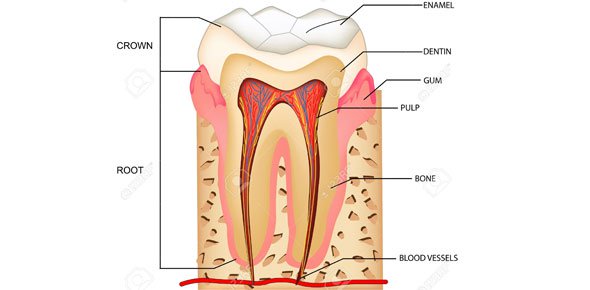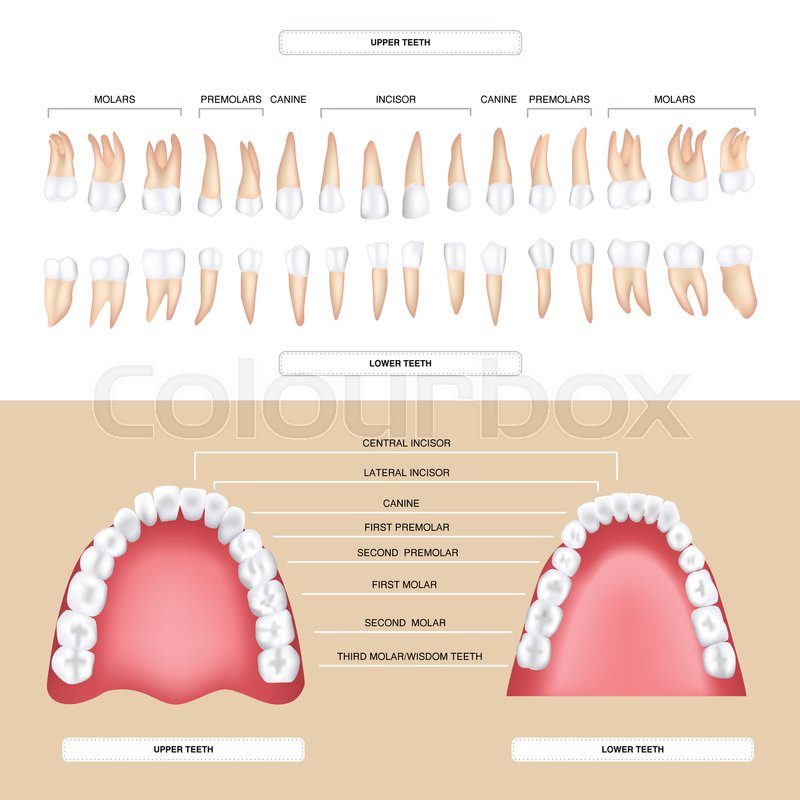Dental Anatomy
Dental anatomy is the study of the human tooth structures. Dental anatomy is also a taxonomical science: it is concerned with the naming of teeth and the structures of which they are made, this information serving a practical purpose in dental treatment.

Overview
While the mouth is a small part of our overall anatomy, it’s filled with many parts and players, all of which work together to help you eat, drink, speak and have a radiant smile. Here’s a quick overview of what’s at play in the average mouth:
Incisors
The sharp, chisel-shaped front teeth (four upper, four lower) used for cutting food.
Canines
Sometimes called cuspids, these teeth are shaped like points (cusps) and are used for tearing and grasping food.
Premolars
These teeth have two pointed cusps on their biting surface and are sometimes referred to as bicuspids. The premolars are for crushing and tearing food.
Molars
Used for grinding and chewing food, these teeth have several cusps on the biting surface to help in this process.
Crown
This is the top part of the tooth, and the only part you can normally see. The shape of the crown determines the tooth's function. For example, front teeth are sharp and chisel-shaped for cutting, while molars have flat surfaces for grinding and chewing.
Gumline
It is the location where the tooth and the gums meet. Without proper brushing and flossing, plaque can build up at the gum line, leading to gingivitis and gum disease.
Root
It is two-thirds of the tooth that is embedded in bone and serves as an anchor to hold the tooth in place.
Enamel
Enamel is the outer and hardest part of the tooth that has the most mineralized tissue in the body. It can be damaged by decay if teeth are not cared for properly.
Dentin
The layer of the tooth under the enamel. If decay makes it through the enamel, it next attacks the dentin — where millions of tiny tubes lead directly to the dental pulp.
Pulp
The soft tissue found in the centre of all teeth, where the nerve tissue and blood vessels are located. If tooth decay reaches the pulp, you usually feel pain and may require a root canal procedure to be done.

Understanding
Thanks to better at-home oral care and in-office dental treatments, more people are keeping their teeth throughout their lives. Some diseases and conditions can make dental diseases and tooth loss more prevalent. However, most of us have a good deal of control over practicing good oral hygiene, so we keep our teeth into our elder years.
Plaque — a sticky layer of bacterial film that forms on your teeth, gums and dental appliances and can cause gingivitis, an inflammation of the gum tissue, or tooth decay. The bacteria in plaque interface with the food we eat to form acids that can cause cavities. Plaque also leads to periodontal (gum) disease. This can become a serious infection which can damage bone and destroy the supporting tissues around your teeth.
The best defense is to remove plaque before it has a chance to build up and cause problems. Tooth brushing removes plaque at and below the gum line and on your tooth surfaces. Flossing removes plaque from between your teeth and below the gum line too. You also can use other oral care devices to keep your mouth and teeth clean.
The most important thing you can do is to brush and floss every day.

Planning
Healthy teeth not only enable you to look and feel good, they make it possible to eat and speak properly. Good oral health is important to your overall well-being.
Daily preventive care, including proper brushing and flossing, will help stop problems before they develop and is much less painful, expensive and worrisome than treating conditions that have been allowed to progress.
In between regular visits to the dentist, there are simple steps that each of us can take to greatly decrease the risk of developing tooth decay, gum disease and other dental problems. These include:
Brushing thoroughly twice a day for two minutes and flossing once daily.
Eating a balanced diet and limiting snacks between meals.
Using toothpaste that contains fluoride.
Rinsing with a fluoride or antibacterial mouth rinse, if your dentist or dental hygienist recommends it to you.
Source: https://bit.ly/2OiM29E https://bit.ly/2OepQNP
Dental anatomy is the study of the human tooth structures. Dental anatomy is also a taxonomical science: it is concerned with the naming of teeth and the structures of which they are made, this information serving a practical purpose in dental treatment.

Overview
While the mouth is a small part of our overall anatomy, it’s filled with many parts and players, all of which work together to help you eat, drink, speak and have a radiant smile. Here’s a quick overview of what’s at play in the average mouth:
Incisors
The sharp, chisel-shaped front teeth (four upper, four lower) used for cutting food.
Canines
Sometimes called cuspids, these teeth are shaped like points (cusps) and are used for tearing and grasping food.
Premolars
These teeth have two pointed cusps on their biting surface and are sometimes referred to as bicuspids. The premolars are for crushing and tearing food.
Molars
Used for grinding and chewing food, these teeth have several cusps on the biting surface to help in this process.
Crown
This is the top part of the tooth, and the only part you can normally see. The shape of the crown determines the tooth's function. For example, front teeth are sharp and chisel-shaped for cutting, while molars have flat surfaces for grinding and chewing.
Gumline
It is the location where the tooth and the gums meet. Without proper brushing and flossing, plaque can build up at the gum line, leading to gingivitis and gum disease.
Root
It is two-thirds of the tooth that is embedded in bone and serves as an anchor to hold the tooth in place.
Enamel
Enamel is the outer and hardest part of the tooth that has the most mineralized tissue in the body. It can be damaged by decay if teeth are not cared for properly.
Dentin
The layer of the tooth under the enamel. If decay makes it through the enamel, it next attacks the dentin — where millions of tiny tubes lead directly to the dental pulp.
Pulp
The soft tissue found in the centre of all teeth, where the nerve tissue and blood vessels are located. If tooth decay reaches the pulp, you usually feel pain and may require a root canal procedure to be done.

Understanding
Thanks to better at-home oral care and in-office dental treatments, more people are keeping their teeth throughout their lives. Some diseases and conditions can make dental diseases and tooth loss more prevalent. However, most of us have a good deal of control over practicing good oral hygiene, so we keep our teeth into our elder years.
Plaque — a sticky layer of bacterial film that forms on your teeth, gums and dental appliances and can cause gingivitis, an inflammation of the gum tissue, or tooth decay. The bacteria in plaque interface with the food we eat to form acids that can cause cavities. Plaque also leads to periodontal (gum) disease. This can become a serious infection which can damage bone and destroy the supporting tissues around your teeth.
The best defense is to remove plaque before it has a chance to build up and cause problems. Tooth brushing removes plaque at and below the gum line and on your tooth surfaces. Flossing removes plaque from between your teeth and below the gum line too. You also can use other oral care devices to keep your mouth and teeth clean.
The most important thing you can do is to brush and floss every day.

Planning
Healthy teeth not only enable you to look and feel good, they make it possible to eat and speak properly. Good oral health is important to your overall well-being.
Daily preventive care, including proper brushing and flossing, will help stop problems before they develop and is much less painful, expensive and worrisome than treating conditions that have been allowed to progress.
In between regular visits to the dentist, there are simple steps that each of us can take to greatly decrease the risk of developing tooth decay, gum disease and other dental problems. These include:
Brushing thoroughly twice a day for two minutes and flossing once daily.
Eating a balanced diet and limiting snacks between meals.
Using toothpaste that contains fluoride.
Rinsing with a fluoride or antibacterial mouth rinse, if your dentist or dental hygienist recommends it to you.
Source: https://bit.ly/2OiM29E https://bit.ly/2OepQNP



No comments:
Post a Comment